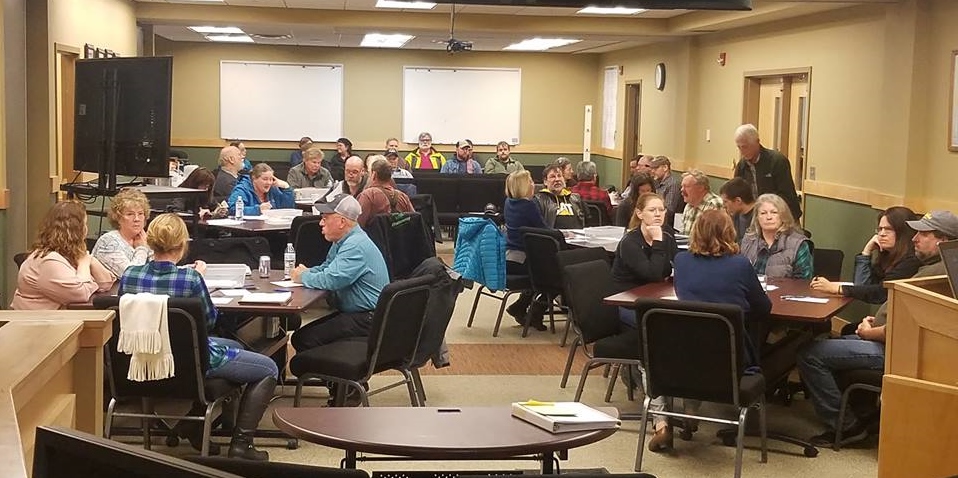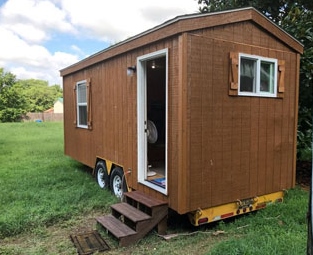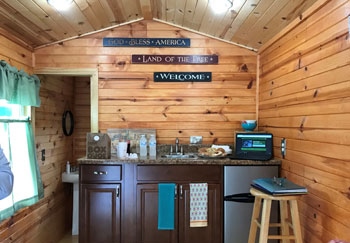
Groups discuss benefits and challenges of tiny homes in Ketchikan Gateway Borough Assembly chambers (photo courtesy of A.J. Pierce).
In November Ketchikan residents gathered to discuss the idea of bringing tiny homes to Alaska’s First City.
Tiny homes could be a solution for affordable housing shortages. But there are hurdles in the form of regulations. Opportunities and challenges were discussed during the forum.
Sharli Arntzen, a realtor and member of the Borough Planning Commission, introduced discussion topics and asked attendees to work in small groups to come up with ideas for addressing them.
“We want to specifically be talking about tiny homes because I hear from the public, and we have other professionals in various different industries here tonight that I’ve also heard (from), that this could potentially a solution to some of our problems.”
The groups discussed benefits and drawbacks of tiny homes, problems people are trying to solve with tiny homes, and perceived challenges.
Arntzen asked the groups to share. They mentioned economic benefits, a possible solution to homelessness, and lower starting costs than traditional homes.
Arntzen believes tiny homes can provide solutions to more than just affordable housing problems.
“We have an aging population that doesn’t have anywhere, necessarily, to go. If they don’t want to live in a 2,000 or 2,500 square-foot house and just want to downsize, it seems like there are some challenges to doing that.”
Arntzen also says affordable, small homes could help students wanting to return to Ketchikan.
“I know many people that I graduated with feel like they can’t come back because the housing is too expensive. If they can work remotely, maybe they have jobs we don’t necessarily have here in Ketchikan, but for them to come back and work remotely is still not cost-effective for them.”
Drawbacks pointed out included infrastructure needs, and the ability to access water and utilities.
Aletha Johnson, assistant borough planner, discussed zoning codes and regulations. She says zoning code applies everywhere in the borough, and additional regulations apply within Ketchikan city limits. Special regulations may also apply in the city of Saxman.
“The City of Ketchikan has building code and fire code and so there’s another layer of regulations within those municipalities. And my part of the presentation applies to all properties within the borough.”
Johnson says zones that could permit tiny homes include low-density residential unrestricted, general commercial and future development. Johnson says it’s best to check with borough planning to find out what can or cannot be built on a particular lot.
Also, she says there are additional restrictions under current code, such as the maximum number of residential units allowed on a lot, requirements for spacing or shared walls, and the need for a conditional use permit to build a tiny home in some zones.
Matt Elbertson, a City of Ketchikan building official, discussed additional requirements if a tiny home is within city limits. He says all homes in the city must be on a permanent foundation, have services, such as sewer and water; and meet other building and fire codes. Elbertson says the city doesn’t have minimum building sizes, but does have minimum room sizes within a dwelling.
“The minimum habitable room size is 70 square-feet, and the minimum dimension in that would be seven feet, so essentially it would be a bedroom that would be 7 by 10. At least one room in a dwelling should be 120 square-feet minimum which would be like a kitchen-living-dining area. And then, of course, you would have to have a bathroom, and there are minimum fixture clearances for the bathroom. So if you’re clever with your planning, you can shoehorn a bathroom into a pretty small spot.”
Nicole Anderson of Davies-Barry Insurance discussed the challenges of insuring tiny homes.
“Insurance doesn’t like ‘crazy out there.’ We like the standard. The normal. And so with this tiny home movement, a lot of insurance carriers are trying to work around it.”
She says tiny homes can be insured with certain requirements. They must be built by a manufacturer or dealer, and placed on a permanent foundation.
“If it’s on a chassis, it can’t be built by the average Joe. As far as a contractor building it? I would have to check with my underwriters. I think in that situation they would need a case by case approval.”
Anderson says for standard homes, policies insure the residence at replacement value. With a tiny home, it can only be insured for cash value.
“That home that cost you $50,000 to build 10 years ago, that tiny home, now has a fire loss. It might only be valued at $20,000. That’s what you’re going to get paid out.”
Also, Anderson says tiny homes can only be insured for “named perils,” such as fire, windstorm and vandalism. She says an example of something that would not be covered is damage from frozen pipes.
The November meeting was just the beginning of Ketchikan’s tiny home discussion. Organizers hope to schedule more forums.










